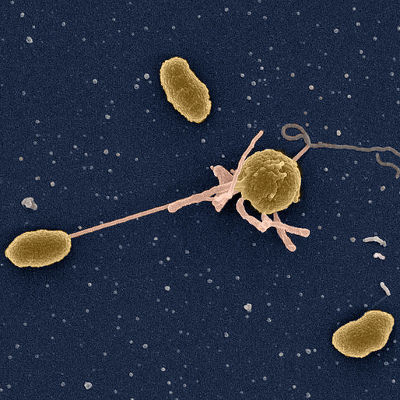Quorum Sensing Subversion and the Promise of Anti-Virulence Therapeutics
A wide variety of bacteria utilize a molecular communication pathway called “quorum sensing” to sense their fellow bacteria and coordinate group actions. In the case of Vibrios, members of a bacterial genus that includes the causal agent of cholera and some food-borne illnesses, quorum sensing is used to collectively determine when to switch from aggressively multiplying and establishing an infection within a host to inducing the host to violently “disseminate” bacteria out both ends. A paper recently published by Ng and colleagues in PLoS Pathogens identified a number of molecules with potential as therapeutics against Vibrios. The molecules act by subverting quorum sensing to inhibit virulence, something that has recently emerged as a promising strategy for the development of anti-infectives.

You may be wondering what’s wrong with good old fashioned antibiotics, whose potency has been one of the pillars of modern medicine since the discovery of penicillin in 1928. Unfortunately, that pillar is crumbling as bacteria evolve resistance to those venerable compounds that have saved countless millions of lives.
This is where anti-virulence compounds come in. In the words of Ng and colleagues, “the advantage of anti-virulence strategies over traditional antibiotics is presumed to be reduced pressure on bacteria to develop resistance”. Rather than removing susceptible bacteria from the gene pool by killing them or halting their growth, as antibiotics do, anti-virulence compounds just disarm bacteria by inhibiting the bacteria’s ability to secrete toxins and immune inhibitors.
Cegelski and colleagues’ review on the subject notes, “some elements of virulence do seem to be fundamental for many pathogens” and, implicitly, drugs that target those elements will exert substantial selective pressure towards the development of resistance in a way similar to antibiotics. However, not all elements of virulence are fundamental. Because quorum sensing is a form of bacterial cooperation, drugs that target it and other ancillary pathways sow dissension within bacterial ranks, so to speak. As a result, the drugs exert only indirect selective pressure on individuals while exerting potent anti-virulence effects on the broader infection.
In fact a study by Mellbye and Schuster demonstrated in a different bacterium, in vitro, that by targeting bacterial cooperation (via quorum sensing) rather than cell growth in a heterogeneous population, bacteria that are more sensitive to the drug may actually survive better than their drug-resistant counterparts. This is because the drug-sensitive bacteria reap the rewards of “social cheating”. This is to say, because drug-sensitive bacteria act selfishly and don’t secrete their share of toxins and immune inhibitors, they reproduce more successfully in the short term than the drug resistant bacteria that invest their energy to help the greater colony. If this is also true in vivo then resistant mutants will be unable to outcompete their drug-susceptible neighbors and, consequently, bacteria will have a fundamentally more difficult time developing resistance to these drugs than to current antibiotics.
The actual degree to which these drugs will be insulated from the development of resistance is still unknown and, indeed, there are no anti-virulence therapeutics yet commercially available, but discoveries of novel anti-virulence compounds such as Ng et al.’s can certainly give us hope that as antibiotics become less effective, science will find new and more durable ways to confront bacterial infections.
Read the article: Broad Spectrum Pro-Quorum-Sensing Molecules as Inhibitors of Virulence in Vibrios.
